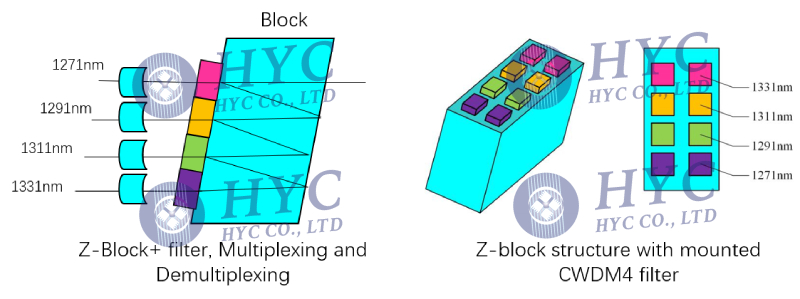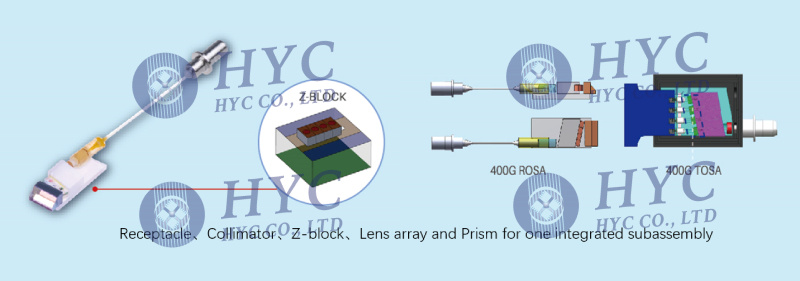The common optical modules are divided into short distance(<2km), middle distance(10~20km), long distance(>30km). According to the typical transmission distance, optical module types are divided into SR (100m), DR (500m), FR (2km), LR (10 km), ER (40 km), ZR (80 km). What do the SR, FR that means?

SR, LR, ER are standard unified optical module structure packaging and related interfaces defined by IEEE, while DR and FR are defined by the MSA organization. SR stands for short reach; the SR optical modules are mostly used Multimode Parallel technology. PSM4(Parallel Single Mode 4 Channels) is the DR short distance (less than 500 meters) optical module, which adopts 1310nm wavelength and Single Mode Parallel technology. The FR CWDM4 module replaces LR module in the range of 500m to 2km, which adopts WDM optics technology. LR(Long Range) supports a distance of up to 10km on single-mode fiber, using CWDM or LWDM wavelength lasers. ER stands for Extended Reach, which supports a distance of up to 40km on single-mode fiber and uses LWDM wavelength lasers. ZR is not an IEEE standard either. It can be transmitted over a distance of 80 kilometers through single-mode fiber, using DWDM wavelength lasers.
There are two ways for the optical module to increase the bandwidth:
1) To increase the bit rate of each channel, such as directly increasing the baud rate or use complex modulation and demodulation methods (such as PAM4);
2) To increase the number of channels, such as increasing the number of parallel fibers or using WDM (CWDM, DWDM).
In the data center, there are two transmission solutions, parallel and WDM. In the current 100G data center, short-distance optical modules use more parallel technology.

What is parallel optics technology?
Parallel optic interfaces differ from traditional fiber optic communication in that data is simultaneously transmitted and received over multiple fibers. Parallel optic technology are primarily targeted for short-reach multimode fiber system of 4×50G,8×50Gbps transmissions.
In parallel optical communication, the devices on either end of the link contain multiple transmitters and receivers, which using multiple fibers to transmit and receive signals. With this configuration, a parallel optics can support every channel containing 10 to 100 Gigabit per second data rate for multiple channels. As shown in the figure below, 8 channels are transmitted in parallel at the same time. That is to say, four transmitters on End A communicate with four receivers on End B, spreading a single stream of data over four optical fibers, reaching a total transmission rate of 200Gbps. Essentially, parallel optical communication is using multiple paths to transmit a signal at a greater data rate than the individual electronics can support which greatly improve the transmission rate.

In long-distance transmission, optical modules generally use WDM(wavelength division multiplexing) technology. WDM is a technology that enables various optical signals to be transmitted by a single fiber, significantly increasing the transmission capacity. It has been widely used in the medium and long-distance transmission of optical communication and the interconnection of data centers.

In the optical module, both Mux and Demux are core passive devices for multiplexing and demultiplexing. Now there are two common main WDM technologies: TFF(Thin-film Filters) based on free-space optics; and AWG(Arrayed Waveguide Grating), EDG(Echelle Diffraction Grating), or MZI(Mach-Zehnder interferometer) based on PLC(Planar Light Circuit).
TFF (Thin Film Filter) technology is mainly implemented in Z-block method, using free-space optics design, combined with collimators, and using 4 CWDM wavelength filters through micro-optics to perform multiplexing and demultiplexing. The first CWDM4 module is based on Z-block technology of TFF. As shown in figure below, eight TFF filters are pasted on an oblique prism in two groups. One group is used for multiplexing and the other group is used for demultiplexing. The transmission wavelengths of each filter are 1271nm, 1291nm, 1311nm and 1331nm respectively.


In order to simplify the packaging process and reduce the size and cost, CWDM4 AWG chip based on integrated optical technology has been developed. AWG is the abbreviation of arrayed waveguide grating, which has been used in telecommunication network for a long time. Both AWG and Z-block are optical components widely used in high-speed optical modules. The comparison shows that Z-block technology has the advantages of low loss and good channel quality, supports long-distance transmission. However, the process of this technology especially for coupling process is difficult, resulting in high cost and inconvenience for large channels application. AWG technology has the lowest process difficulty and cost. It meets the demand of cost reduction in data center market and is gradually replacing Z-block technology in the market. The current problem is the wavelength stability and manufacturing process. If this problem is solved, it will be the better solution.

AWG in telecommunication network is used to multiplex/demultiplex DWDM optical signals. The channel spacing is usually 200G or 100G (corresponding to wavelength spacing of 1.6nm or 0.8nm) and it usually has 32/40/48 channels. Because the application scenario is mainly the backbone of the telecommunication network, it is not sensitive to the cost. Structure of a typical AWG is shown in Fig. It consists of five parts: a transmitter waveguide, an input star coupler (FPR (free propagation region) ), arrayed waveguides, an output star coupler and dozens of receiver waveguides.
The CWDM4 module based on Z-block technology can even support 100G signal transmission for 10km. AWG technology has the lowest process difficulty and cost, and it widely used in receiver ends of traditional optical modules. AWG and TFF both have advantages in transmitter ends of optical modules.
About HYC Co., Ltd
With 23 years manufacturing experience of passive optical devices, HYC has professional optical simulation and analysis capabilities, and the back-end processing workshop is equipped with complete set of cutting and testing equipment, which can provide various customized high-precision optical subassemblies either with parallel optics technology or WDM optics technology for high-speed transceivers.
